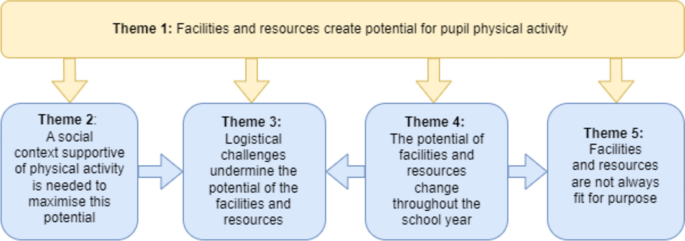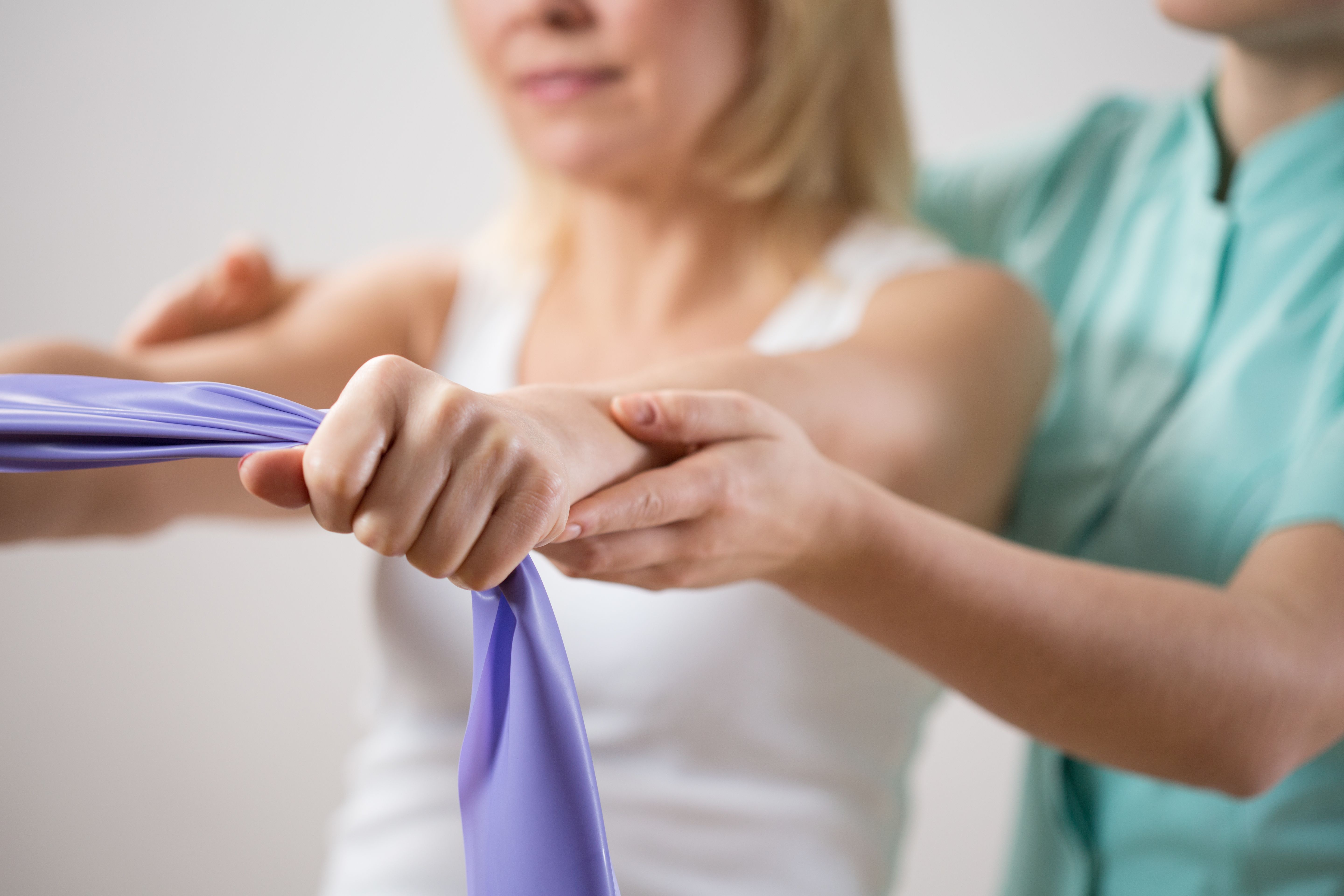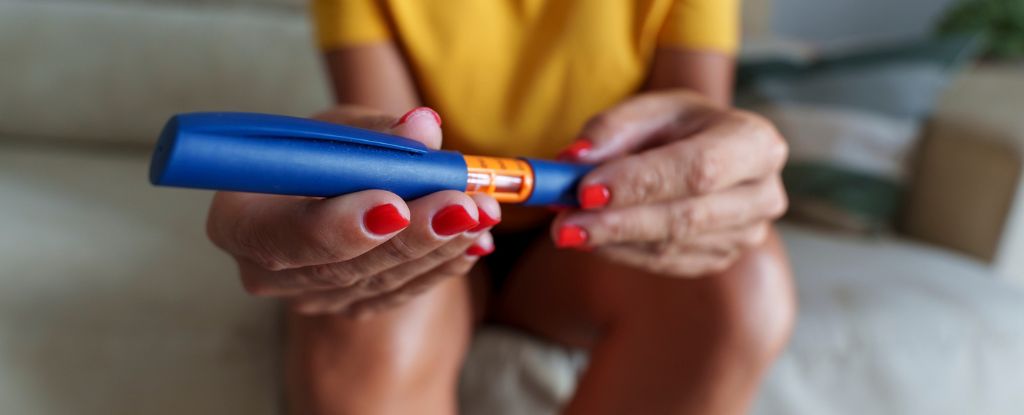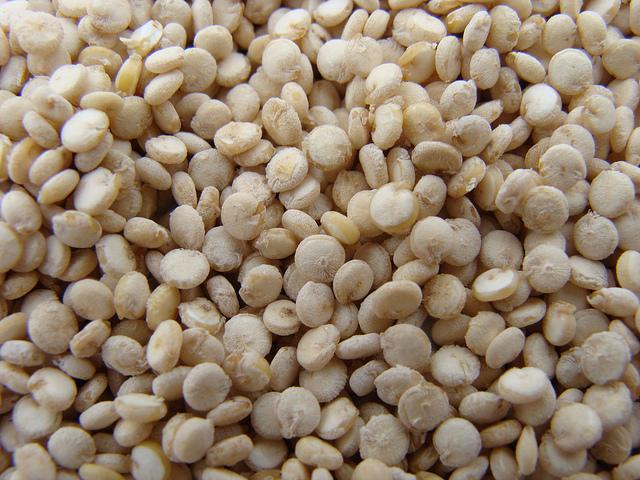“We just have to work with what we’ve got”: a qualitative analysis of contextual challenges in facilities and resources for pupil physical activity in English primary schools | BMC Public Health

Five themes were generated related to the contextual factors that influence the potential of school facilities and resources to support pupil physical activity. These are: 1) Facilities and resources create potential for pupil physical activity, 2) A social context supportive of physical activity is needed to maximise this potential, 3) Logistical challenges undermine the potential of facilities and resources, 4) The potential of facilities and resources change throughout the school year, and 5) Facilities and resources are not always fit for purpose. Table 3 provides an overview of the themes generated and a brief description, and Fig. 1 shows the theme relationship.

Engagement with our data highlighted that the language used by participants varied across contexts. We therefore generated the following definitions that we felt best captured the meanings within our data. By facilities we mean the spaces in the built environment of a school (or elsewhere, if schools access offsite facilities) that are used for pupil PE and physical activity, such as playgrounds or indoor halls. By resources we are referring to the additional elements needed to undertake PE and physical activity in these facilities, namely, equipment, staff (including external provision), and teaching materials. The inclusion of not just facilities (built environment) but the resources needed to enliven these was data driven, as the relatedness of these was clear throughout the interviews. Furthermore, in this analysis we include discussion of both PE, as a foundational subject in a school’s curriculum, and broader physical activity, the opportunities across a school day for children to be active. We recognise the limitation of combining these and do not see these as interchangeable. However, the terms were often used interchangeably by participants as PE leads or teachers often have responsibility for broader pupil physical activity, e.g. active clubs. Within the aim of this study to examine the role of school facilities and resources in pupil physical activity, discussion of PE and physical activity was present across the data.
Theme 1: facilities and resources create potential for pupil physical activity
Across the interviews, participants explained how the facilities and resources schools have access to created potential for their PE teaching and broader physical activity provision for pupils. Several schools recognised how their facilities, such as indoor halls or outdoor space, supported the quantity and quality of their provision and enabled them to support pupil activity. For example, one school expressed that they feel lucky to have the facilities to ensure children have spaces where they can be active:
“So we’re quite lucky in the school. So I said, yeah, we’ve got two halls, they’re great. We lost a bit of space because we built the Year 5 classes when the school went bigger on the lower playground. But we still have an upper playground and we’ve got something called a MUGA, which is a multi-use games space, and then we’ve got a large field.”(Participant 10, Class Teacher, school FSM% 9.8, IMD 10)
Conversely, schools reported the challenge of a lack of facilities and resources, and how greater availability of, for example, indoor space for PE or sports equipment to engage a greater number of pupils or provide broader opportunities, would benefit pupils and positively impact what the schools can do, demonstrating the related nature of facilities and resources. As one participant explains:
“It’s space. If we could have a bigger shed to house more equipment, we’d have more equipment. The equipment 1740551213 is the bare essentials, the bare minimum. Yes, I think space is a huge issue.” (Participant 12, PE Lead, school FSM% 10.8, IMD 8
This was also apparent in terms of staff as a resource to support physical activity opportunities, where several schools commented that they were able to provide opportunities because they had a large teaching staff body, or conversely that they were a smaller school and so unable to staff many opportunities such as active clubs and or taking children to competitions.
“We’re quite lucky in this school, obviously it being large. […] Because every teacher is encouraged to do a club. So obviously, having a large teaching force, we can therefore offer loads of clubs.” (Participant 10, Class Teacher, school FSM% 9.8, IMD 10)
However, across the interviews, participants gave nuanced insights into how facilities and resources are used, maintained, and engaged with, which undermined or maximised the potential of these to support pupils to be active, demonstrating the complex relationship between school facilities and pupil physical activity. The following four themes explore these aspects.
Theme 2: a social context supportive of physical activity is needed to maximise this potential
This theme identifies a connection between how a schools’ social context, i.e. their staff experience and values, their pupils, and their priorities (Walker, et al.: The complexity of promoting physical activity in English state primary schools: an in-depth qualitative analysis of the role of social context, Under review), shapes how facilities and resources are maximised for pupil physical activity. Participants expressed a sense that a school has to make a concerted effort to maximise the facilities and resources they have for physical activity, and that if a school did not prioritise this then facilities could be under-utilised. The ‘buy in’ of staff at all levels – Senior Leadership Team (SLT), PE teachers/leads, class teachers, and lunch time supervisors – to maximise the potential of facilities, was explicitly noted by many participants as more important than the simple existence of the facilities (Theme 1).
“I think regardless of how much space we’ve got, which we are very fortunate to have, without that buy-in, that space had might as well be dead land. We’d might as well sell it and let developers build on it, kind of thing, because if you haven’t got that buy in from everyone, it doesn’t work.” (Participant 11, Class Teacher and SLT, school FSM% 31.6, IMD 2)
However, the role of the SLT specifically in this buy in was clear, due to their role in setting school priorities and strategies (Walker, et al.: The complexity of promoting physical activity in English state primary schools: an in-depth qualitative analysis of the role of social context, Under review). For example, SLT could maximise or undermine the potential of facilities and resources via decisions around maintenance (particularly in a context of squeezed school finances), training staff to utilise facilities and resources to support children to engage with these, staff resourcing for break times, or incentivising staff to run extra-curricular clubs (both active and others).
“[the school] don’t really have [a site team] at the moment. So, that has an immediate knock-on with, at the moment, leaves that are everywhere. So, using the MUGA [multi-use games area] can be unsafe, because it can be slippery. […] And if they don’t have anyone to clean it, the kids can’t use it. There’s a trim trail [a series of play equipment] at the top, it’s out of bounds quite often, just with a piece of tape around it, because it can’t be maintained if there’s no site team.” (Participant 1, Parent Teacher Association Chair, school FSM% 36.6, IMD 2)
“There are always bikes, scooters, skateboards and things like that [in the playground]. But there’s not always football on anymore, because you need one member of staff to run it on the football pitch. […] There used to be SLT [available] and sometimes there isn’t a member to do that anymore.” (Participant 4, Teaching Assistant, school FSM% 48.0, IMD 1)
However, across the interviews, primary school staff also provided examples of how they worked to overcome limitations of their facilities and resources by finding innovative solutions and making adaptations to maximise the physical activity opportunities and quality for their pupils. Some schools had adapted their school uniform policy so pupils arrive dressed for PE on PE days, and others had taken on a universal active uniform. Those with an active uniform explained that children could then be active throughout the day, maximising breaktimes for physical activity, as they are always appropriately dressed. Other schools incentivised pupils to maintain sports and play equipment when there was no staff capacity to do so.
“…we’ve got PE leaders [within Year 6 classes]. […] once a week they go outside, do a bit of general tidying, ensuring the resources are pumped up so that actually when you want to go out and use them, you can actually use them rather than getting there and all the basketballs are flat. So it’s kept in a decent order.” (Participant 10, Class Teacher, school FSM% 9.8, IMD 10)
Theme 3: logistical challenges undermine the potential of the facilities and resources
Logistical challenges consistently came through as a barrier to using and maximising the potential of the facilities and resources a school has or has access to. A school may have spaces or equipment for activity, but the use of these competed against other school priorities, and so the existence of them alone was not enough to ensure PE and wider pupil physical activity. Timetabling of school indoor space specifically was frequently mentioned. Participants described a number of uses for indoor halls, such as pupil assemblies, rehearsals for school plays, as dining halls for lunch, and as spaces used by wrap-around childcare before and after school. Scheduling these facilities can be very challenging for schools and undermined their potential to be used for pupil physical activity.
“[The PE teacher] timetables it so different year groups are doing gym [in the hall] at different points of the year. […But] every now and again there’s a school performance that needs the hall on a Wednesday afternoon and that’s your PE slot.” (Participant 10, Class Teacher, school FSM% 9.8, IMD 10)
Lunch and break times were often described as too short to warrant getting out equipment for pupils to use, and transitions between classroom-based lessons and PE or movement breaks, especially if children had to change clothes, further eroded the time for engagement in physical activity. Class teachers who teach PE described being unable to prepare a space or equipment for a lesson in advance because the space would be in use until the moment their class began. Teachers have to transition from their classroom to the PE space with pupils, and therefore often rely on using equipment that is minimal and quick to set up in order to manage class behaviour. This issue has been compounded by staffing pressures in schools, where previous capacity for Teaching Assistants (TAs) to set up for a PE lesson, take a class for a movement break, or support break time activities is being lost (Theme 1).
“[break time is] such a short session so we don’t get a lot [of equipment] out because it’s only 15 minutes. By the time you’ve got it out, it’s time to put it back in again.” (Participant 7, Deputy Head, school FSM% 15.3, IMD 4)
“This year, there’s a new set-up where the [TAs] aren’t really per classroom. They’re spread out. […] I think that does impact things like Daily Mile [a movement break] and smaller bits of activities in the day. Because the TA would do that. They’d take them out while the teacher could sort something else out and now they can’t do that anymore.” (Participant 4, Teaching Assistant, school FSM% 48.0, IMD 1)
Theme 4: the potential of facilities and resources change throughout the school year
This theme establishes how the potential of facilities and resources to support pupil physical activity changes across the school year. Although timetabling of facilities and other logistical issues are always a challenge in school and impact on pupil physical activity (Theme 3), the extent of this changes with the seasons.
Schools described outdoor spaces that were unusable for several months of the year usually due to wet weather making fields muddy or MUGAs/sports courts slippery. Exacerbating this, in these seasons staff avoided pupils going outside in the rain as pupils often do not have appropriate clothing for the weather, which impacts PE, break times, and active clubs. This was described as the downside of an active uniform, or children coming dressed for PE on PE days, as they had no change of clothes if they got wet during a PE lesson. These factors increased the pressure on indoor facilities that are already maximised (Theme 3), and in turn school staff described cancelling PE lessons or attempting to do them in classrooms or other inappropriate spaces.
“If your PE session is at 10:00 in the morning and it’s drizzly and raining, then children have got to come back inside for the rest of the day and sit in damp clothes. Because at this school […] when it’s your PE day, you come in dressed in your PE kit. […] The drawback in that is, obviously, that’s their kit for the rest of the day, so if they get wet, there’s no backup clothing to change into.” (Participant 10, Class Teacher, school FSM% 9.8, IMD 10)
“so it’s rained for God knows how long, so then you can’t get out, or the court is flooded, or whatever. […] if that happens, then there are two options. One, we’ll put on a yoga video, or we’ll just do something else. And then the PE doesn’t get rescheduled, because those [indoor] spaces are so packed.” (Participant 14, PE Lead, school FSM% 20.9, IMD 4)
However, there are also seasonal moments in a school year when facilities are under increased pressure due to other school activities which are prioritised, which further undermines the potential of facilities and resources to support pupil activity (Themes 2 and 3). Times mentioned included the weeks before Christmas and the final summer term when school halls are often used for rehearsals for school plays or other seasonal activities, or when halls are needed for pupils to sit school exams. When these periods of additional priorities combine with poor weather the pressure on facilities is increased.
“we’ve got the Nativity that need the indoor hall for their practice, and things like that, we have various things going on, like, I don’t know, a space dome is coming in, they need the hall. So PE often will have to get moved for those things, and if it gets moved, it just doesn’t get done” (Participant 14, PE Lead, school FSM% 20.9, IMD 4)
Theme 5: facilities and resources are not always fit for purpose
School staff described how physical activity facilities and resources are not always fit for purpose. Quality was described as an issue, such as old or broken equipment. This of course can be solved through simply replacing or increasing these resources (Theme 1), and has been touched upon already in terms of the maintenance of facilities (Theme 2) and the seasonality of facilities such as fields (Theme 4).
However, schools elaborated on the issue of how fit for purpose both outdoor and indoor facilities were, beyond issues that could be solved by replacing or upgrading, demonstrating that the presence of a facility does not always mean it is suitable for physical activity. Fields were described as bumpy or sloped (not just seasonally) so not suitable for sports day or athletics. The design and location of indoor halls were also an issue for some schools, where some had features that inhibited sport and activity, and others were located with classrooms leading onto the hall, which was disruptive both for pupils in classroom lessons and pupils doing PE in the hall.
“Inside the building, we have got two lovely big halls, but the classrooms […] all feed off of the hall, […]. It is really difficult getting the children’s attention because there’s so much stuff going on, there are people walking through all the time, and there’s people having conversations. […] The acoustics in the hall are awful, so things like that are barriers.” (Participant 2, PE Lead, school FSM% 31.6, IMD 2)
“[Our hall] is a reasonable size. But there are two massive pillars in the middle of it, because they’re holding up this- They’re key for the structural support of the [building] above. Most visitors wonder how I teach PE in there, because it looks quite strange.” (Participant 15, Dedicated PE Teacher, school FSM% 18.3, IMD 6)
Issues of how fit for purpose physical activity resources were also came through in regards to the external provision of PE and sport coaches, PE curriculum resources, and external schemes for PE and physical activity. Many primary schools buy in private external companies to provide PE, lunch time activities, and staff continuing professional development (CPD). Participants described experiencing great variety in the quality of these external coaches, who were seen as highly skilled in teaching sport, but at times lacking the broader skills needed to manage emotional wellbeing, behaviour, and diverse pupil needs.
“Some sports coaches are brilliant. Some of them are not, particularly when you have a class with more complex needs and you need to have that experience of working with lots of different children.” (Participant 32, Deputy Headteacher, school FSM% 9.7, IMD 3)
Participants described how PE curriculum resources that a school bought in, or external schemes for PE and physical activity such as the Daily Mile, are often not adaptable or suitable to their particular school context. These schemes at times made assumptions about the facilities a school could access, the amount of equipment they would have, or the length of time that schools give to a session (Theme 3).
“we find with lots of [physical activity schemes] they’re catered towards large schools, and do not work for us at all.” (Participant 33, PE Lead, school FSM% 7.1, IMD 7)
“I brainstormed so many ways, thinking, ‘How could we get that [The Daily Mile] to work in our school?’ it’s just a physical impossibility.” (Participant 15, Dedicated PE Teacher, school FSM% 18.3, IMD 6)
link







